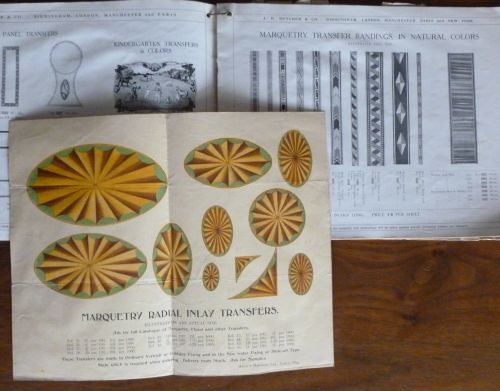|
|
04/12/2011 |
 Marquetry is a decorative technique where wood veneers are sawn into a pattern and then assembled like a jigsaw. Inlay is similar but instead of assembling a large panel of veneer, the decoration is inset into a recess cut into a larger panel of wood. Marquetry is a decorative technique where wood veneers are sawn into a pattern and then assembled like a jigsaw. Inlay is similar but instead of assembling a large panel of veneer, the decoration is inset into a recess cut into a larger panel of wood.
I can think of three ways of doing marquetry and inlay. The first is actually doing it. While not an impossible skill to learn, like any high end technique it requires training, practice, and time. Both historically and today work by the masters of these techniques command high prices amongst a well heeled customer base. Take a look at two modern masters:
W. Patrick Edwards does reproductions of classic 18th century French work. He works entirely by hand using traditional techniques.
Silas Kopf uses a wide variety of techniques and works entirely in a modern vocabulary of design and theme.
Both men are at the top of the game.
The second way of doing "marquetry" is by painting it on. I've seen a lot of this and done right it reads like marquetry and is pretty simple for anyone with a steady hand to do. Up close of course it's pretty apparent it's paint. You can apply a thin layer of paint so the underlying grain reads through or a thick layer that is more opaque.
The third technique of "marquetry" was very popular, especially in England up to around the 1930's. As in the US where the popular taste was Colonial Revival, in England mid priced Victorian copies were popular. The solution to getting all that fancy marquetry at a common price was ... Decals! (or transfers as they say in England) In the picture above is a catalog of designs and some color samples from the J. H. Butcher & Co. dating from 1913. A furniture maker would simply buy whatever decals they wanted to decorate the piece, and it was fairly simple to apply. I first saw this decoration as a kid in my grandparents house. It looks pretty good for what it is, especially if it's under a glass top, or there are some doilies on the furniture. The catalog contains every style of decoration including the latest Art Nouveau styles. The catalog is mostly printed in black and white but the transfers are promised in "natural inlay colors".
I mention these techniques because while today we might not want to duplicate mediocre Victorian furniture, not everyone has the budget for the real thing. Low budget should not require us to surround ourselves with knock-offs of post war Danish designs, or minimalist versions of the latter as found in Ikea. Most of my furniture I have made is Arts and Crafts style, which I like but is also within my range of skill (I can't carve or inlay) but I think in the hands of a better designer than I these techniques of painting on detail, creating decals, and other shortcuts might make some basic bespoke furniture more interesting to the modern eye and differentiate it from mass production styles with not so much increase in cost. |
Join the conversation |
|
 Joel's Blog
Joel's Blog Built-It Blog
Built-It Blog Video Roundup
Video Roundup Classes & Events
Classes & Events Work Magazine
Work Magazine


 Marquetry is a decorative technique where wood veneers are sawn into a pattern and then assembled like a jigsaw. Inlay is similar but instead of assembling a large panel of veneer, the decoration is inset into a recess cut into a larger panel of wood.
Marquetry is a decorative technique where wood veneers are sawn into a pattern and then assembled like a jigsaw. Inlay is similar but instead of assembling a large panel of veneer, the decoration is inset into a recess cut into a larger panel of wood.